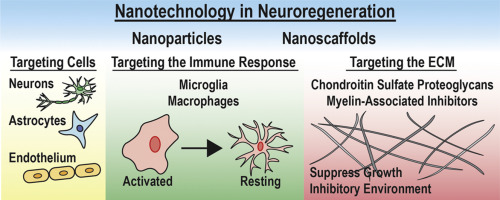Advanced Drug Delivery Reviews ( IF 15.2 ) Pub Date : 2019-04-17 , DOI: 10.1016/j.addr.2019.04.004 Kevin Liaw , Zhi Zhang , Sujatha Kannan

|
Identifying and harnessing regenerative pathways while suppressing the growth-inhibiting processes of the biological response to injury is the central goal of stimulating neurogenesis after central nervous system (CNS) injury. However, due to the complexity of the mature CNS involving a plethora of cellular pathways and extracellular cues, as well as difficulties in accessibility without highly invasive procedures, clinical successes of regenerative medicine for CNS injuries have been extremely limited. Current interventions primarily focus on stabilization and mitigation of further neuronal death rather than direct stimulation of neurogenesis. In the past few decades, nanotechnology has offered substantial innovations to the field of regenerative medicine. Their nanoscale features allow for the fine tuning of biological interactions for enhancing drug delivery and stimulating cellular processes. This review gives an overview of nanotechnology applications in CNS regeneration organized according to cellular and extracellular targets and discuss future directions for the field.
中文翻译:

神经纳米技术可促进大脑再生
识别和利用再生途径,同时抑制对损伤的生物学反应的生长抑制过程,是刺激中枢神经系统(CNS)损伤后神经发生的主要目标。然而,由于涉及大量细胞途径和细胞外提示的成熟CNS的复杂性,以及在没有高侵入性程序的情况下难以获得,用于CNS损伤的再生医学的临床成功受到了极大的限制。当前的干预主要集中于稳定和减轻进一步的神经元死亡,而不是直接刺激神经发生。在过去的几十年中,纳米技术为再生医学领域提供了实质性的创新。它们的纳米级特征允许对生物相互作用进行微调,以增强药物传递和刺激细胞过程。这篇综述概述了根据细胞和细胞外靶标组织的中枢神经系统再生中的纳米技术应用,并讨论了该领域的未来方向。











































 京公网安备 11010802027423号
京公网安备 11010802027423号